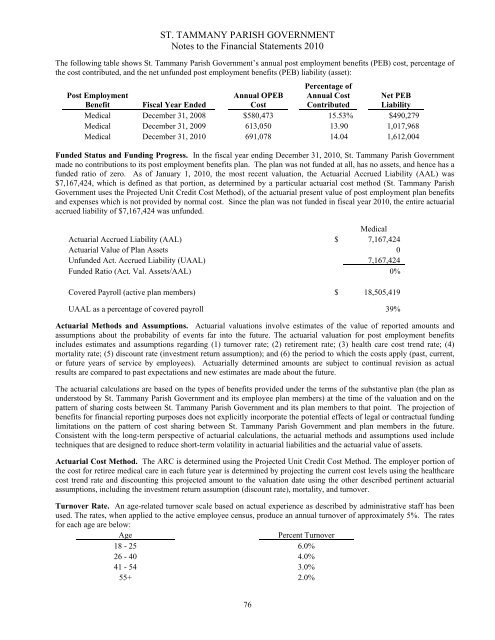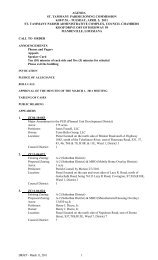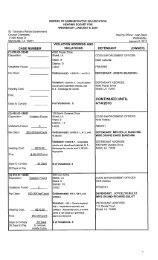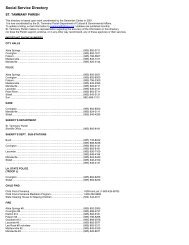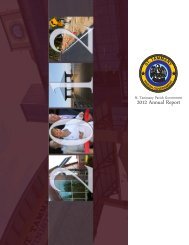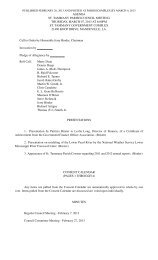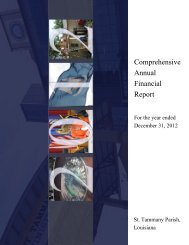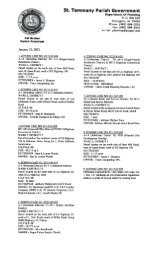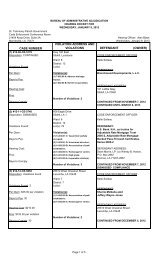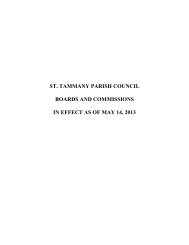Comprehensive Annual Financial Report - St. Tammany Parish ...
Comprehensive Annual Financial Report - St. Tammany Parish ...
Comprehensive Annual Financial Report - St. Tammany Parish ...
Create successful ePaper yourself
Turn your PDF publications into a flip-book with our unique Google optimized e-Paper software.
ST. TAMMANY PARISH GOVERNMENT<br />
Notes to the <strong>Financial</strong> <strong>St</strong>atements 2010<br />
The following table shows <strong>St</strong>. <strong>Tammany</strong> <strong>Parish</strong> Government’s annual post employment benefits (PEB) cost, percentage of<br />
the cost contributed, and the net unfunded post employment benefits (PEB) liability (asset):<br />
Post Employment<br />
Benefit<br />
Percentage of<br />
<strong>Annual</strong> Cost<br />
Contributed<br />
Fiscal Year Ended<br />
<strong>Annual</strong> OPEB<br />
Cost<br />
Net PEB<br />
Liability<br />
Medical December 31, 2008 $580,473 15.53% $490,279<br />
Medical December 31, 2009 613,050 13.90 1,017,968<br />
Medical December 31, 2010 691,078 14.04 1,612,004<br />
Funded <strong>St</strong>atus and Funding Progress. In the fiscal year ending December 31, 2010, <strong>St</strong>. <strong>Tammany</strong> <strong>Parish</strong> Government<br />
made no contributions to its post employment benefits plan. The plan was not funded at all, has no assets, and hence has a<br />
funded ratio of zero. As of January 1, 2010, the most recent valuation, the Actuarial Accrued Liability (AAL) was<br />
$7,167,424, which is defined as that portion, as determined by a particular actuarial cost method (<strong>St</strong>. <strong>Tammany</strong> <strong>Parish</strong><br />
Government uses the Projected Unit Credit Cost Method), of the actuarial present value of post employment plan benefits<br />
and expenses which is not provided by normal cost. Since the plan was not funded in fiscal year 2010, the entire actuarial<br />
accrued liability of $7,167,424 was unfunded.<br />
Medical<br />
Actuarial Accrued Liability (AAL) $ 7,167,424<br />
Actuarial Value of Plan Assets 0<br />
Unfunded Act. Accrued Liability (UAAL) 7,167,424<br />
Funded Ratio (Act. Val. Assets/AAL) 0%<br />
Covered Payroll (active plan members) $ 18,505,419<br />
UAAL as a percentage of covered payroll 39%<br />
Actuarial Methods and Assumptions. Actuarial valuations involve estimates of the value of reported amounts and<br />
assumptions about the probability of events far into the future. The actuarial valuation for post employment benefits<br />
includes estimates and assumptions regarding (1) turnover rate; (2) retirement rate; (3) health care cost trend rate; (4)<br />
mortality rate; (5) discount rate (investment return assumption); and (6) the period to which the costs apply (past, current,<br />
or future years of service by employees). Actuarially determined amounts are subject to continual revision as actual<br />
results are compared to past expectations and new estimates are made about the future.<br />
The actuarial calculations are based on the types of benefits provided under the terms of the substantive plan (the plan as<br />
understood by <strong>St</strong>. <strong>Tammany</strong> <strong>Parish</strong> Government and its employee plan members) at the time of the valuation and on the<br />
pattern of sharing costs between <strong>St</strong>. <strong>Tammany</strong> <strong>Parish</strong> Government and its plan members to that point. The projection of<br />
benefits for financial reporting purposes does not explicitly incorporate the potential effects of legal or contractual funding<br />
limitations on the pattern of cost sharing between <strong>St</strong>. <strong>Tammany</strong> <strong>Parish</strong> Government and plan members in the future.<br />
Consistent with the long-term perspective of actuarial calculations, the actuarial methods and assumptions used include<br />
techniques that are designed to reduce short-term volatility in actuarial liabilities and the actuarial value of assets.<br />
Actuarial Cost Method. The ARC is determined using the Projected Unit Credit Cost Method. The employer portion of<br />
the cost for retiree medical care in each future year is determined by projecting the current cost levels using the healthcare<br />
cost trend rate and discounting this projected amount to the valuation date using the other described pertinent actuarial<br />
assumptions, including the investment return assumption (discount rate), mortality, and turnover.<br />
Turnover Rate. An age-related turnover scale based on actual experience as described by administrative staff has been<br />
used. The rates, when applied to the active employee census, produce an annual turnover of approximately 5%. The rates<br />
for each age are below:<br />
Age<br />
Percent Turnover<br />
18 - 25 6.0%<br />
26 - 40 4.0%<br />
41 - 54 3.0%<br />
55+ 2.0%<br />
76


